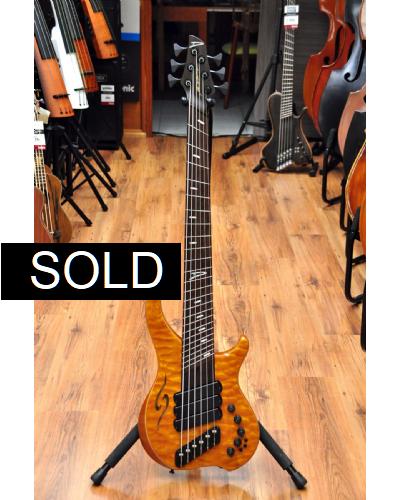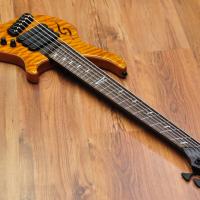Canadian luthier Sheldon Dingwall has been building amazing instruments since the early 90's and he was a true pioneer as he incorporated the Multiscale or Fanned Fret System that had been developed by Ralph Novak and that meant that every string on the instrument should have a different lenght depending on the pitch it should give when played open. The fact that every string has a different lenght of course means that the frets have to be installed in a "fanned" manner, hence the name.
Even if these basses look modern and rad, they are based on the same principle of old harps and pianos. The strings on a grand piano or harp vary in lenght depending on the note. This means that the lower the note, the longer the string must be. Even upright pianos feature a harp with different string lengths. The result of this is that the harmonic series from the strings is larger and the tone is therefore fuller. Pure physics.
Up until now we concentrated on the successful Combustion, D-Roc and NG lines. These are all excellent value for money basses carefully crafted in China.
However this bass is the real deal. 100% made in Saskatoon, Canada by Sheldon Dingwall and his small team of craftsmen. Doesn’t get any better, believe us. It is a 6 string bass and it belongs in the Custom shop series of instruments. The models made in Canada are the following: Prima Artist, Lee Sklar Signature, Super-J, Super-P, D-Roc, ABZ, Afterburner I and Afterburner II. This particular bass is an Afterburner II and it is the top of the line.
The body is made from walnut and as you can see in the pictures, it is hollowbody which has several advantages: Walnut sounds very similar to Alder, but with more clarity, sustain and punch. Weight is reduced and resonance increases by adding strategic tone chambers throughout the body.
This model usually sports a figured walnut top but in this case it is a gorgeous piece of quilted maple. Really cool.
Dingwall takes neck construction very seriously due to their extensive experience in guitar repairs coupled with their geographic location and corresponding extreme climate. Sheldon Dingwall says that in his years in the guitar repair business he constantly had to deal with humidity related problems made worse by the huge temperature and humidity swings of their local climate. Many of these problems could have been minimized through simple design changes and materials choices.
Touring musicians are constantly amazed at how stable Dingwall instruments are. Many state that their Dingwall necks are as stable as their graphite necked instruments.
Dingwall has experimented with many different laminations and in this case they have chosen a 3 piece wenge laminate because it is very stable and will be roughly 50 grams heavier than maple with an open grain feel . The tone is similar to maple but with a slightly snappier response.
The double expanding truss-rod style is one of the industry standards. However, Dingwall's method of installation – taught to them by Glenn McDougall of Fury Guitars, involves gluing the truss rod into the neck under almost 1000-LB of pressure. This creates a coupling of steel to wood increasing both sustain and harmonic content.
Sheldom says: “While repairing guitars, I found that many guitars had either stripped or missing truss rod cover plate screws. I found it frustrating that it usually took longer to remove and replace the cover plate than it did to do the actual adjustment.” The truss rod is the most commonly adjusted component on most guitars, so access to the truss rod adjustment should be as easy as possible. All Dingwall basses feature easy to access truss-rod adjustments.
Dual carbon fiber reinforcements are installed in Walnut Afterburner II necks. This stiffens the Walnut and also increases sustain and clarity.
Headstock design is flat, counter bored. The design goal was to utilize a flat headstock design. Materials and labor savings are significant with this design. The only problem was that a flat headstock needs a string tree to create proper downward angle at the nut. It took some creative thinking and custom made tuners to solve this problem in the most elegant way possible. The headstock features special counter bores that when combined with Dingwall's custom tuners allows proper break angle at the nut. A side benefit is that these special made Hipshot Ultra-lites are even lighter than the originals. Combined with the minimalist Afterburner headstock shape, the improved balance is significant.
Wenge is an interesting fretboard wood due to the alternating layers of hard and soft grain (early and late wood). The hard grain gives the tone a nice top end similar to ebony and the soft grain adds the warmth of Rosewood. It’s a great all around fingerboard wood.
Vintage small size 18% hard nickel silver fretwire. Lee Sklar turned Dingwall onto the benefits of small frets. The advantages are a more woody, less metallic tone, smoother glissandos and a faster feel. The standard size is “banjo” size. This is the same size as you’d find on most guitars from the 50’s and 60’s. Although its size is smaller than standard bass fretwire, its service life is about the same.
We love the original and practical fingerboard inlays which follow a circular pattern. They lean towards the bass side in the first octave and the opposite past the 12th fret (which has a nice D inlay)
FDV pickups are the standard pickup in our Afterburner II model. They are a continuation of the FD (Fury/Dingwall) line of pickups but feature Alnico V magnets instead of Neodymium. Their tone and response is the most traditional sounding and feeling of all Dingwall pickups yet they maintain the tightness and clarity that Dingwall basses are known for. They feature 4-lead wiring which enables the internal coils to be wired in either series for strong mids and high output or parallel for scooped mids and normal output. The Afterburner II comes standard with 2 pickups in traditional spacing. The 3 pickup option that you get on this bass adds a middle pickup for even more tone options and we really dig that because it makes the bass much more versatile.
This is a passive-active bass. Pull the Volume pot for Passive and push for active. All Dingwall basses feature a 4-position rotary pickup selector. The rotary switch does two things. It reduces the load on the pickups compared to a standard blend control and it offers 4 distinct bass tones that are all very musically useful and versatile.
The amount of sounds on tap here is excellent.
1-Bridge
2- Bridge + Middle in Series (MM Style)
3- Bridge + Neck in Parallel (J-Style)
4- Neck
The standard passive system is amazingly versatile. Even more so with the addition of series/parallel toggle switches. There are 3 of these switches, one for each pickup.
If you want even more tone shaping at your fingertips, just engage the excellent Glockenklang 3-band preamp. The cool thing about the Glockenklang pre-amps is the smooth and subtle tone shaping and the Active/Passive treble control. Dingwall spends a lot of time perfecting the natural tone of their basses so that they don’t need a lot of tone adjustment. The Glockenklang really fits well with this philosophy. The Active treble boosts and cuts as expected in active mode but when the pre-amp is switched to passive mode, the control is switched to a passive cut control. This is essentially like having two basses with two distinct characters. One active and one passive.
When you need to replace the battery all you have to do is pull the cover at the back with your fingers as it uses a clever magnet system. This removes the stress of having to find a screwdriver to replace the battery and saves a lot of time too.
Of course the Low B speaks with amazing clarity due to the 37” scale. Absolutely perfect. At the same time the G and C strings are not too tight feeling/sounding due to 34” and 33.25” scale. Mustiscale basses really work, but on a 6 string this system makes even more sense.
We love the Neutrik Locking jack that prevents your cable from coming out of the bass accidentally.
We’ve saved for the end one of the most striking features of this bass: balance. Being an extra long scale lightweight 6 string bass you would think that neck diving would be an issue but we are extremely happy to report that it isn’t. This is achieved by the use of a small headstock, the lightest tuners in the planet (lighter than your standard Hipshot Ultralite series) and a well designed body and neck. Just by placing your right arm lightly on the body for standard playing position you get a perfect balance. We are impressed. Comfort is really important on any bass but when it comes to 6 string basses even more.
If you’ve been thinking about getting a really good 6 string bass but you still haven’t found your cup of tea, this might really be the one. Comfort, playability, versatility, quaility of sound, perfect string to string balance and impressive looks are the definition of this Dingwall Afterburner II 6 string bass.





